Evaluation of Solar Radiation Prediction Models Using AI: A Performance Comparison in the High-Potential Region of Konya, Türkiye
Abstract
1. Introduction
- 1.
- To compare the SR prediction performances of different machine learning models and determine the method with the best predictive capacity.
- 2.
- To improve prediction accuracy by using various hydro-meteorological data and analyzing the extent to which these data influence solar radiation prediction.
- 3.
- Comparing deep learning models such as LSTM, Bi-LSTM, GRU, and Bi-GRU with traditional ML methods and advanced boosting algorithms (LSBoost, XGBoost, Bagging, Random Forest) to identify the most effective method for time series prediction.
- 4.
- To conduct a statistical analysis of the prediction models using ANOVA and Kruskal–Wallis tests and determine whether there are significant differences among the predictions of different models.
- 5.
- To identify the best-performing model(s) and develop reliable prediction models for solar energy systems and renewable energy applications.
- 6.
- The performance of the proposed models was evaluated using data from Konya, Turkey, a region with significant energy potential.
2. Materials and Methods
2.1. Study Area
2.2. Data Collection
2.3. Prediction Models
2.3.1. LSTM
2.3.2. BiLSTM
2.3.3. GRU
2.3.4. BiGRU
2.3.5. LSBoost
2.3.6. XGBoost
2.3.7. Bagging
2.3.8. Random Forest
2.3.9. SVM
2.3.10. GRNN
2.3.11. MANN
2.3.12. RBANN
2.4. Metrics for Performance Evaluation of Models
3. Results
4. Discussion
5. Conclusions
Funding
Institutional Review Board Statement
Informed Consent Statement
Data Availability Statement
Acknowledgments
Conflicts of Interest
References
- Albergel, C.; Dutra, E.; Munier, S.; Calvet, J.-C.; Munoz-Sabater, J.; de Rosnay, P.; Balsamo, G. ERA-5 and ERA-Interim Driven ISBA Land Surface Model Simulations: Which One Performs Better? Hydrol. Earth Syst. Sci. 2018, 22, 3515–3532. [Google Scholar] [CrossRef]
- Khamees, A.S.; Sayad, T.; Morsy, M.; Ali Rahoma, U. Evaluation of Three Radiation Schemes of the WRF-Solar Model for Global Surface Solar Radiation Forecast: A Case Study in Egypt. Adv. Space Res. 2024, 73, 2880–2891. [Google Scholar] [CrossRef]
- Gao, X.-J.; Shi, Y.; Giorgi, F. Comparison of Convective Parameterizations in RegCM4 Experiments over China with CLM as the Land Surface Model. Atmos. Ocean. Sci. Lett. 2016, 9, 246–254. [Google Scholar] [CrossRef]
- Lockwood, J.G. Atmospheric Circulation, Global. In Climatology Encyclopedia of Earth Science; Springer: Boston, MA, USA, 1987; pp. 131–140. [Google Scholar]
- Krishnan, N.; Kumar, K.R.; Inda, C.S. How Solar Radiation Forecasting Impacts the Utilization of Solar Energy: A Critical Review. J. Clean. Prod. 2023, 388, 135860. [Google Scholar] [CrossRef]
- Kumler, A.; Kravitz, B.; Draxl, C.; Vimmerstedt, L.; Benton, B.; Lundquist, J.K.; Martin, M.; Buck, H.J.; Wang, H.; Lennard, C.; et al. Potential Effects of Climate Change and Solar Radiation Modification on Renewable Energy Resources. Renew. Sustain. Energy Rev. 2025, 207, 114934. [Google Scholar] [CrossRef]
- Abdallah, M.; Mohammadi, B.; Nasiri, H.; Katipoğlu, O.M.; Abdalla, M.A.A.; Ebadzadeh, M.M. Daily Global Solar Radiation Time Series Prediction Using Variational Mode Decomposition Combined with Multi-Functional Recurrent Fuzzy Neural Network and Quantile Regression Forests Algorithm. Energy Rep. 2023, 10, 4198–4217. [Google Scholar] [CrossRef]
- Huang, J.; Jing, L.; Zhang, Q.; Zong, S.; Zhang, A. Interfacial Solar Vapor Evaporator Based on Biologically Natural Composites. Nano Energy 2025, 133, 110458. [Google Scholar] [CrossRef]
- Mehdizadeh, S.; Mohammadi, B.; Pham, Q.B.; Duan, Z. Development of Boosted Machine Learning Models for Estimating Daily Reference Evapotranspiration and Comparison with Empirical Approaches. Water 2021, 13, 3489. [Google Scholar] [CrossRef]
- Mohammadi, B.; Moazenzadeh, R. Performance Analysis of Daily Global Solar Radiation Models in Peru by Regression Analysis. Atmosphere 2021, 12, 389. [Google Scholar] [CrossRef]
- Mohanty, S.; Patra, P.K.; Sahoo, S.S. Prediction and Application of Solar Radiation with Soft Computing over Traditional and Conventional Approach—A Comprehensive Review. Renew. Sustain. Energy Rev. 2016, 56, 778–796. [Google Scholar] [CrossRef]
- Qin, S.; Liu, Z.; Qiu, R.; Luo, Y.; Wu, J.; Zhang, B.; Wu, L.; Agathokleous, E. Short–Term Global Solar Radiation Forecasting Based on an Improved Method for Sunshine Duration Prediction and Public Weather Forecasts. Appl. Energy 2023, 343, 121205. [Google Scholar] [CrossRef]
- Almorox, J.; Hontoria, C. Global Solar Radiation Estimation Using Sunshine Duration in Spain. Energy Convers. Manag. 2004, 45, 1529–1535. [Google Scholar] [CrossRef]
- Duzen, H.; Aydin, H. Sunshine-Based Estimation of Global Solar Radiation on Horizontal Surface at Lake Van Region (Turkey). Energy Convers. Manag. 2012, 58, 35–46. [Google Scholar] [CrossRef]
- Almorox, J.; Bocco, M.; Willington, E. Estimation of Daily Global Solar Radiation from Measured Temperatures at Cañada de Luque, Córdoba, Argentina. Renew. Energy 2013, 60, 382–387. [Google Scholar] [CrossRef]
- Fan, J.; Chen, B.; Wu, L.; Zhang, F.; Lu, X.; Xiang, Y. Evaluation and Development of Temperature-Based Empirical Models for Estimating Daily Global Solar Radiation in Humid Regions. Energy 2018, 144, 903–914. [Google Scholar] [CrossRef]
- Gu, L.; Fuentes, J.D.; Garstang, M.; Da Silva, J.T.; Heitz, R.; Sigler, J.; Shugart, H.H. Cloud Modulation of Surface Solar Irradiance at a Pasture Site in Southern Brazil. Agric. For. Meteorol. 2001, 106, 117–129. [Google Scholar] [CrossRef]
- Kostić, R.; Mikulović, J. The Empirical Models for Estimating Solar Insolation in Serbia by Using Meteorological Data on Cloudiness. Renew. Energy 2017, 114, 1281–1293. [Google Scholar] [CrossRef]
- Chen, J.-L.; He, L.; Yang, H.; Ma, M.; Chen, Q.; Wu, S.-J.; Xiao, Z. Empirical Models for Estimating Monthly Global Solar Radiation: A Most Comprehensive Review and Comparative Case Study in China. Renew. Sustain. Energy Rev. 2019, 108, 91–111. [Google Scholar] [CrossRef]
- Fan, J.; Wang, X.; Wu, L.; Zhang, F.; Bai, H.; Lu, X.; Xiang, Y. New Combined Models for Estimating Daily Global Solar Radiation Based on Sunshine Duration in Humid Regions: A Case Study in South China. Energy Convers. Manag. 2018, 156, 618–625. [Google Scholar] [CrossRef]
- Qiu, R.; Liu, C.; Cui, N.; Gao, Y.; Li, L.; Wu, Z.; Jiang, S.; Hu, M. Generalized Extreme Gradient Boosting Model for Predicting Daily Global Solar Radiation for Locations without Historical Data. Energy Convers. Manag. 2022, 258, 115488. [Google Scholar] [CrossRef]
- Feng, Y.; Gong, D.; Zhang, Q.; Jiang, S.; Zhao, L.; Cui, N. Evaluation of Temperature-Based Machine Learning and Empirical Models for Predicting Daily Global Solar Radiation. Energy Convers. Manag. 2019, 198, 111780. [Google Scholar] [CrossRef]
- Kurgansky, M.V.; Krupchatnikov, V.N. Dynamic Meteorology. Russ. Natl. Rep. Meteorol. Atmos. 2019, 152. [Google Scholar]
- Hammer, A.; Heinemann, D.; Lorenz, E.; Lückehe, B. Short-Term Forecasting of Solar Radiation: A Statistical Approach Using Satellite Data. Sol. Energy 1999, 67, 139–150. [Google Scholar] [CrossRef]
- Lorenz, E.; Hammer, A.; Heienmann, D. Short Term Forecasting of Solar Radiation Based on Cloud Motion Vectors from Satellite Images. ISES Eur. Sol. Congr. 2004, 1, 841–848. [Google Scholar]
- White, J.W.; Hoogenboom, G.; Wilkens, P.W.; Stackhouse, P.W.; Hoel, J.M. Evaluation of Satellite-Based, Modeled-Derived Daily Solar Radiation Data for the Continental United States. Agron. J. 2011, 103, 1242–1251. [Google Scholar] [CrossRef]
- Qing, X.; Niu, Y. Hourly Day-Ahead Solar Irradiance Prediction Using Weather Forecasts by LSTM. Energy 2018, 148, 461–468. [Google Scholar] [CrossRef]
- Sharda, S.; Singh, M.; Sharma, K. RSAM: Robust Self-Attention Based Multi-Horizon Model for Solar Irradiance Forecasting. IEEE Trans. Sustain. Energy 2021, 12, 1394–1405. [Google Scholar] [CrossRef]
- Hassan, M.A.; Khalil, A.; Kaseb, S.; Kassem, M.A. Exploring the Potential of Tree-Based Ensemble Methods in Solar Radiation Modeling. Appl. Energy 2017, 203, 897–916. [Google Scholar] [CrossRef]
- Notton, G.; Voyant, C.; Fouilloy, A.; Duchaud, J.L.; Nivet, M.L. Some Applications of ANN to Solar Radiation Estimation and Forecasting for Energy Applications. Appl. Sci. 2019, 9, 209. [Google Scholar] [CrossRef]
- Demir, V.; Citakoglu, H. Forecasting of Solar Radiation Using Different Machine Learning Approaches. Neural Comput. Appl. 2023, 35, 887–906. [Google Scholar] [CrossRef]
- Demirgül, T.; Demir, V.; Sevimli, M.F. Forecasting of HELIOSAT-Based Solar Radiation by Model-Tree (M5-Tree) Approach. Geomatik 2023, 8, 124–135. [Google Scholar] [CrossRef]
- Jiang, C.; Zhu, Q. Evaluating the Most Significant Input Parameters for Forecasting Global Solar Radiation of Different Sequences Based on Informer. Appl. Energy 2023, 348, 121544. [Google Scholar] [CrossRef]
- Neshat, M.; Nezhad, M.M.; Mirjalili, S.; Garcia, D.A.; Dahlquist, E.; Gandomi, A.H. Short-Term Solar Radiation Forecasting Using Hybrid Deep Residual Learning and Gated LSTM Recurrent Network with Differential Covariance Matrix Adaptation Evolution Strategy. Energy 2023, 278, 127701. [Google Scholar] [CrossRef]
- Marinho, F.P.; Rocha, P.A.C.; Neto, A.R.R.; Bezerra, F.D.V. Short-Term Solar Irradiance Forecasting Using CNN-1D, LSTM, and CNN-LSTM Deep Neural Networks: A Case Study With the Folsom (USA) Dataset. J. Sol. Energy Eng. 2023, 145, 041002. [Google Scholar] [CrossRef]
- Ehteram, M.; Afshari Nia, M.; Panahi, F.; Farrokhi, A. Read-First LSTM Model: A New Variant of Long Short Term Memory Neural Network for Predicting Solar Radiation Data. Energy Convers. Manag. 2024, 305, 118267. [Google Scholar] [CrossRef]
- Zhang, C.; Zhang, Y.; Pu, J.; Liu, Z.; Wang, Z.; Wang, L. An Hourly Solar Radiation Prediction Model Using EXtreme Gradient Boosting Algorithm with the Effect of Fog-Haze. Energy Built Environ. 2025, 6, 18–26. [Google Scholar] [CrossRef]
- Solano, E.S.; Dehghanian, P.; Affonso, C.M. Solar Radiation Forecasting Using Machine Learning and Ensemble Feature Selection. Energies 2022, 15, 7049. [Google Scholar] [CrossRef]
- Huang, L.; Kang, J.; Wan, M.; Fang, L.; Zhang, C.; Zeng, Z. Solar Radiation Prediction Using Different Machine Learning Algorithms and Implications for Extreme Climate Events. Front. Earth Sci. 2021, 9, 596860. [Google Scholar] [CrossRef]
- Abumohsen, M.; Owda, A.Y.; Owda, M.; Abumihsan, A. Hybrid Machine Learning Model Combining of CNN-LSTM-RF for Time Series Forecasting of Solar Power Generation. Adv. Electr. Eng. Electron. Energy 2024, 9, 100636. [Google Scholar] [CrossRef]
- Perez-Rodriguez, S.A.; Alvarez-Alvarado, J.M.; Romero-Gonzalez, J.A.; Aviles, M.; Mendoza-Rojas, A.E.; Fuentes-Silva, C.; Rodriguez-Resendiz, J. Metaheuristic Algorithms for Solar Radiation Prediction: A Systematic Analysis. IEEE Access 2024, 12, 100134–100151. [Google Scholar] [CrossRef]
- Mendyl, A.; Demir, V.; Omar, N.; Orhan, O.; Weidinger, T. Enhancing Solar Radiation Forecasting in Diverse Moroccan Climate Zones: A Comparative Study of Machine Learning Models with Sugeno Integral Aggregation. Atmosphere 2024, 15, 103. [Google Scholar] [CrossRef]
- Mirbolouki, A.; Heddam, S.; Singh Parmar, K.; Trajkovic, S.; Mehraein, M.; Kisi, O. Comparison of the Advanced Machine Learning Methods for Better Prediction Accuracy of Solar Radiation Using Only Temperature Data: A Case Study. Int. J. Energy Res. 2022, 46, 2709–2736. [Google Scholar] [CrossRef]
- Hissou, H.; Benkirane, S.; Guezzaz, A.; Azrour, M.; Beni-Hssane, A. A Novel Machine Learning Approach for Solar Radiation Estimation. Sustainability 2023, 15, 10609. [Google Scholar] [CrossRef]
- Kisi, O.; Parmar, K.S. Application of Least Square Support Vector Machine and Multivariate Adaptive Regression Spline Models in Long Term Prediction of River Water Pollution. J. Hydrol. 2016, 534, 104–112. [Google Scholar] [CrossRef]
- Alizamir, M.; Othman Ahmed, K.; Shiri, J.; Fakheri Fard, A.; Kim, S.; Heddam, S.; Kisi, O. A New Insight for Daily Solar Radiation Prediction by Meteorological Data Using an Advanced Artificial Intelligence Algorithm: Deep Extreme Learning Machine Integrated with Variational Mode Decomposition Technique. Sustainability 2023, 15, 11275. [Google Scholar] [CrossRef]
- Alizamir, M.; Shiri, J.; Fard, A.F.; Kim, S.; Gorgij, A.D.; Heddam, S.; Singh, V.P. Improving the Accuracy of Daily Solar Radiation Prediction by Climatic Data Using an Efficient Hybrid Deep Learning Model: Long Short-Term Memory (LSTM) Network Coupled with Wavelet Transform. Eng. Appl. Artif. Intell. 2023, 123, 106199. [Google Scholar] [CrossRef]
- Hussain, S.; AlAlili, A. A Hybrid Solar Radiation Modeling Approach Using Wavelet Multiresolution Analysis and Artificial Neural Networks. Appl. Energy 2017, 208, 540–550. [Google Scholar] [CrossRef]
- Qiu, R.; Li, L.; Wu, L.; Agathokleous, E.; Liu, C.; Zhang, B.; Luo, Y.; Sun, S. Modeling Daily Global Solar Radiation Using Only Temperature Data: Past, Development, and Future. Renew. Sustain. Energy Rev. 2022, 163, 112511. [Google Scholar] [CrossRef]
- Voyant, C.; Notton, G.; Kalogirou, S.; Nivet, M.-L.; Paoli, C.; Motte, F.; Fouilloy, A. Machine Learning Methods for Solar Radiation Forecasting: A Review. Renew. Energy 2017, 105, 569–582. [Google Scholar] [CrossRef]
- Pedro, H.T.C.; Coimbra, C.F.M.; David, M.; Lauret, P. Assessment of Machine Learning Techniques for Deterministic and Probabilistic Intra-Hour Solar Forecasts. Renew. Energy 2018, 123, 191–203. [Google Scholar] [CrossRef]
- Chen, T.; Guestrin, C. XGBoost: A Scalable Tree Boosting System. In Proceedings of the 22nd ACM Sigkdd International Conference on Knowledge Discovery and Data Mining, San Francisco, CA, USA, 13–17 August 2016; pp. 785–794. [Google Scholar] [CrossRef]
- Fan, J.; Wang, X.; Wu, L.; Zhou, H.; Zhang, F.; Yu, X.; Lu, X.; Xiang, Y. Comparison of Support Vector Machine and Extreme Gradient Boosting for Predicting Daily Global Solar Radiation Using Temperature and Precipitation in Humid Subtropical Climates: A Case Study in China. Energy Convers. Manag. 2018, 164, 102–111. [Google Scholar] [CrossRef]
- Alam, M.S.; Al-Ismail, F.S.; Hossain, M.S.; Rahman, S.M. Ensemble Machine-Learning Models for Accurate Prediction of Solar Irradiation in Bangladesh. Processes 2023, 11, 908. [Google Scholar] [CrossRef]
- Krishnan, N.; Ravi Kumar, K. Solar Radiation Forecasting Using Gradient Boosting Based Ensemble Learning Model for Various Climatic Zones. Sustain. Energy Grids Networks 2024, 38, 101312. [Google Scholar] [CrossRef]
- Orhan, O.; Yakar, M.; Ekercin, S. An Application on Sinkhole Susceptibility Mapping by Integrating Remote Sensing and Geographic Information Systems. Arab. J. Geosci. 2020, 13, 886. [Google Scholar] [CrossRef]
- Demir, V.; Keskin, A.Ü. Water Level Change of Lakes and Sinkholes in Central Turkey under Anthropogenic Effects. Theor. Appl. Climatol. 2020, 142, 929–943. [Google Scholar] [CrossRef]
- General Directorate of Meteorology Türkiye Global Solar Radiation Long-Year Average (2004–2021) Heliosat Model Products. Available online: https://www.mgm.gov.tr/kurumici/radyasyon_iller.aspx?il=konya (accessed on 1 January 2025).
- Hochreiter, S.; Schmidhuber, J. Long Short-Term Memory. Neural Comput. 1997, 9, 1735–1780. [Google Scholar] [CrossRef] [PubMed]
- Xu, L.; Shi, P.; Wu, H.; Qu, S.; Li, Q.; Sun, Y.; Yang, X.; Jiang, P.; Qiu, C. Investigating the Potential of EMA-Embedded Feature Selection Method for ESVR and LSTM to Enhance the Robustness of Monthly Streamflow Forecasting from Local Meteorological Information. J. Hydrol. 2024, 636, 131230. [Google Scholar] [CrossRef]
- Wang, H.; Zhang, J.; Yang, J. Time Series Forecasting of Pedestrian-Level Urban Air Temperature by LSTM: Guidance for Practitioners. Urban Clim. 2024, 56, 102063. [Google Scholar] [CrossRef]
- Hou, Z.; Wang, B.; Zhang, Y.; Zhang, J.; Song, J. Drought Prediction in Jilin Province Based on Deep Learning and Spatio-Temporal Sequence Modeling. J. Hydrol. 2024, 642, 131891. [Google Scholar] [CrossRef]
- Wang, T.; Tu, X.; Singh, V.P.; Chen, X.; Lin, K.; Zhou, Z. Drought Prediction: Insights from the Fusion of LSTM and Multi-Source Factors. Sci. Total Environ. 2023, 902, 166361. [Google Scholar] [CrossRef]
- Zhao, R.; Wang, D.; Yan, R.; Mao, K.; Shen, F.; Wang, J. Machine Health Monitoring Using Local Feature-Based Gated Recurrent Unit Networks. IEEE Trans. Ind. Electron. 2018, 65, 1539–1548. [Google Scholar] [CrossRef]
- Zhang, W.; Li, H.; Tang, L.; Gu, X.; Wang, L.; Wang, L. Displacement Prediction of Jiuxianping Landslide Using Gated Recurrent Unit (GRU) Networks. Acta Geotech. 2022, 17, 1367–1382. [Google Scholar] [CrossRef]
- Anki, P.; Bustamam, A.; Buyung, R.A. Comparative Analysis of Performance between Multimodal Implementation of Chatbot Based on News Classification Data Using Categories. Electronics 2021, 10, 2696. [Google Scholar] [CrossRef]
- Aloraifan, D.; Ahmad, I.; Alrashed, E. Deep Learning Based Network Traffic Matrix Prediction. Int. J. Intell. Networks 2021, 2, 46–56. [Google Scholar] [CrossRef]
- Küllahcı, K.; Altunkaynak, A. Eigen Time Series Modeling: A Breakthrough Approach to Spatio-Temporal Rainfall Forecasting in Basins. Neural Comput. Appl. 2024, 37, 4471–4492. [Google Scholar] [CrossRef]
- Dong, J.; Zeng, W.; Wu, L.; Huang, J.; Gaiser, T.; Srivastava, A.K. Enhancing Short-Term Forecasting of Daily Precipitation Using Numerical Weather Prediction Bias Correcting with XGBoost in Different Regions of China. Eng. Appl. Artif. Intell. 2023, 117, 105579. [Google Scholar] [CrossRef]
- Bushara, N.O.; Abraham, A. Novel Ensemble Method for Long Term Rainfall Prediction. Int. J. Comput. Inf. Syst. Ind. Manag. Appl. 2015, 7, 116–130. [Google Scholar]
- Kundu, S.; Biswas, S.K.; Tripathi, D.; Karmakar, R.; Majumdar, S.; Mandal, S. A Review on Rainfall Forecasting Using Ensemble Learning Techniques. e-Prime—Adv. Electr. Eng. Electron. Energy 2023, 6, 100296. [Google Scholar] [CrossRef]
- Ho, T.K. Random Decision Forests. In Proceedings of the Proceedings of 3rd International Conference on Document Analysis And Recognition, Montreal, QC, Canada, 14–16 August 1995; IEEE: Piscataway, NJ, USA, 1995; Volume 1, pp. 278–282. [Google Scholar]
- Mosavi, A.; Sajedi Hosseini, F.; Choubin, B.; Goodarzi, M.; Dineva, A.A.; Rafiei Sardooi, E. Ensemble Boosting and Bagging Based Machine Learning Models for Groundwater Potential Prediction. Water Resour. Manag. 2021, 35, 23–37. [Google Scholar] [CrossRef]
- Vapnik, V. The Nature of Statistical Learning Theory; Springer: New York, NY, USA, 1995. [Google Scholar]
- Cortes, C.; Vapnik, V. Support-Vector Networks. Mach. Learn. 1995, 20, 273–297. [Google Scholar] [CrossRef]
- Smola, A. Regression Estimation with Support Vector Learning Machines. Master’s Thesis, Tech Univ Munchen, Munich, Germany, 1996. [Google Scholar]
- Smola, A.J.; Schölkopf, B. A Tutorial on Support Vector Regression. Stat. Comput. 2004, 14, 199–222. [Google Scholar]
- Eldakhly, N.M.; Aboul-Ela, M.; Abdalla, A. A Novel Approach of Weighted Support Vector Machine with Applied Chance Theory for Forecasting Air Pollution Phenomenon in Egypt. Int. J. Comput. Intell. Appl. 2018, 17, 1850001. [Google Scholar] [CrossRef]
- Raghavendra, N.S.; Deka, P.C. Support Vector Machine Applications in the Field of Hydrology: A Review. Appl. Soft Comput. 2014, 19, 372–386. [Google Scholar] [CrossRef]
- Kişi, Ö. A Combined Generalized Regression Neural Network Wavelet Model for Monthly Streamflow Prediction. KSCE J. Civ. Eng. 2011, 15, 1469–1479. [Google Scholar] [CrossRef]
- Varol Malkoçoğlu, A.; Orman, Z.; Şamlı, R. Comparison of Different Heuristics Integrated with Neural Networks: A Case Study for Earthquake Damage Estimation. Acta Infologica 2022, 6, 265–281. [Google Scholar] [CrossRef]
- Çubukçu, E.A.; Demir, V.; Sevimli, M.F. Modeling of Annual Maximum Flows with Geographic Data Components and Artificial Neural Networks. Int. J. Eng. Geosci. 2022, 8, 200–211. [Google Scholar] [CrossRef]
- Broomhead, D.S.; Lowe, D. Multivariable Functional Interpolation and Adaptive Networks. Complex Syst. 1988, 2, 321–355. [Google Scholar]
- Demir, V.; Doğu, R. Estimation of Elevation Points Obtained by Remote Sensing Techniques by Different Artificial Neural Network Methods. Turkish J. Remote Sens. 2023, 5, 59–66. [Google Scholar] [CrossRef]
- Çubukçu, E.A.; Demir, V.; Sevimli, M.F. Digital Elevation Modeling Using Artificial Neural Networks, Deterministic and Geostatistical Interpolation Methods. Turkish J. Eng. 2021, 6, 199–205. [Google Scholar] [CrossRef]
- Taylor, E.K. Summarizing Multiple Aspects of Model Performance in a Single Diagram. J. Geophys. Res. Atmos. 2001, 106, 7183–7192. [Google Scholar] [CrossRef]
- Legouhy, A. Al_goodplot—Boxblot & Violin Plot. Available online: https://www.mathworks.com/matlabcentral/fileexchange/91790-al_goodplot-boxblot-violin-plot (accessed on 1 January 2024).
- Demir, V. Enhancing Monthly Lake Levels Forecasting Using Heuristic Regression Techniques with Periodicity Data Component: Application of Lake Michigan. Theor. Appl. Climatol. 2022, 148, 915–929. [Google Scholar] [CrossRef]
- Kumar, M.; Kumar, P. Stage-discharge-sediment modelling using support vector machine. Pharma Innov. J. 2021, 10, 149–154. [Google Scholar]
- Saleh, A.; Tan, M.L.; Yaseen, Z.M.; Zhang, F. Integrated machine learning models for enhancing tropical rainfall prediction using NASA POWER meteorological data. J. Water Clim. Chang. 2024, 15, 6022–6042. [Google Scholar] [CrossRef]
- Zhang, B. The effect of aerosols to climate change and society. J. Geosci. Environ. Prot. 2020, 8, 55. [Google Scholar] [CrossRef]
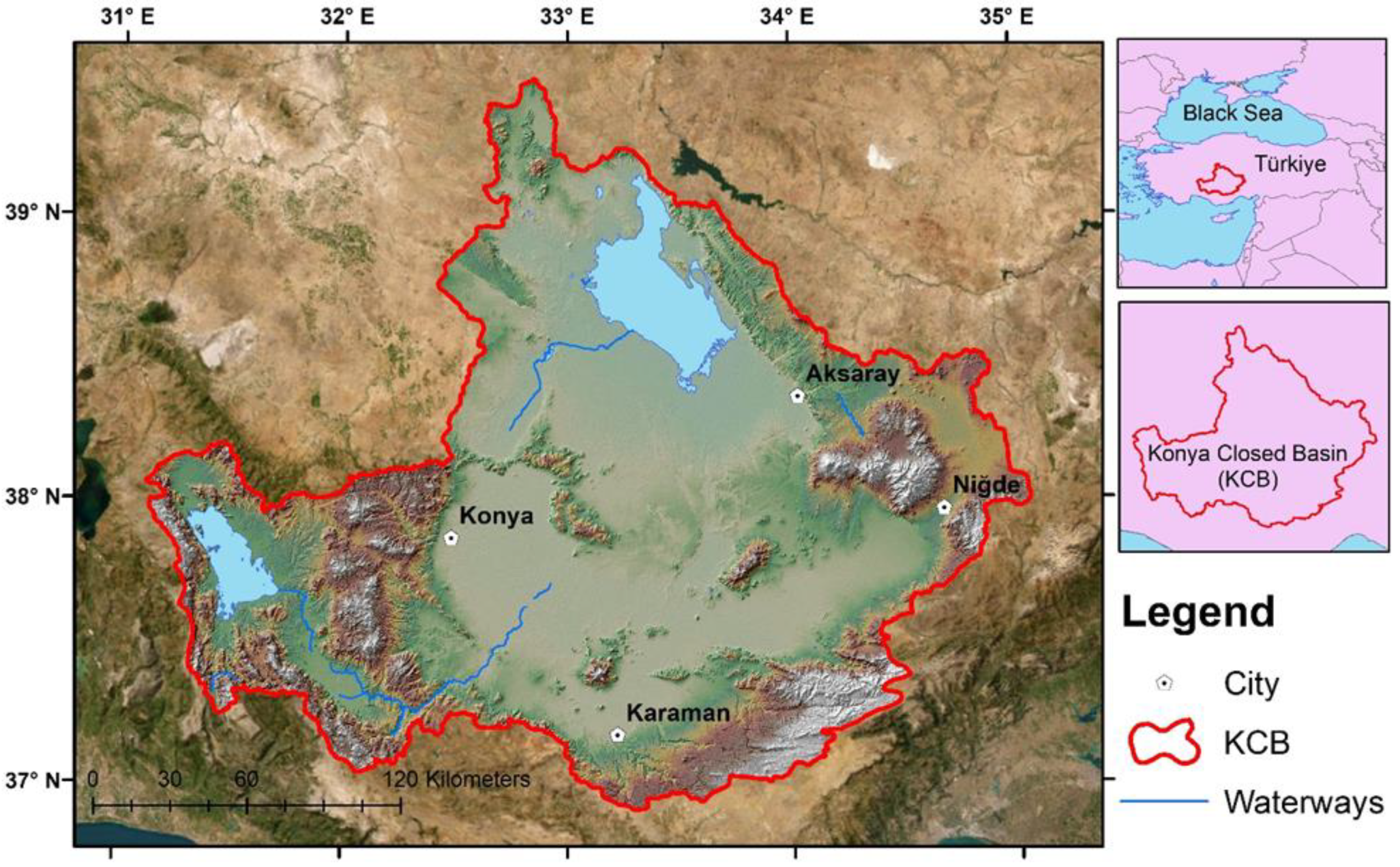
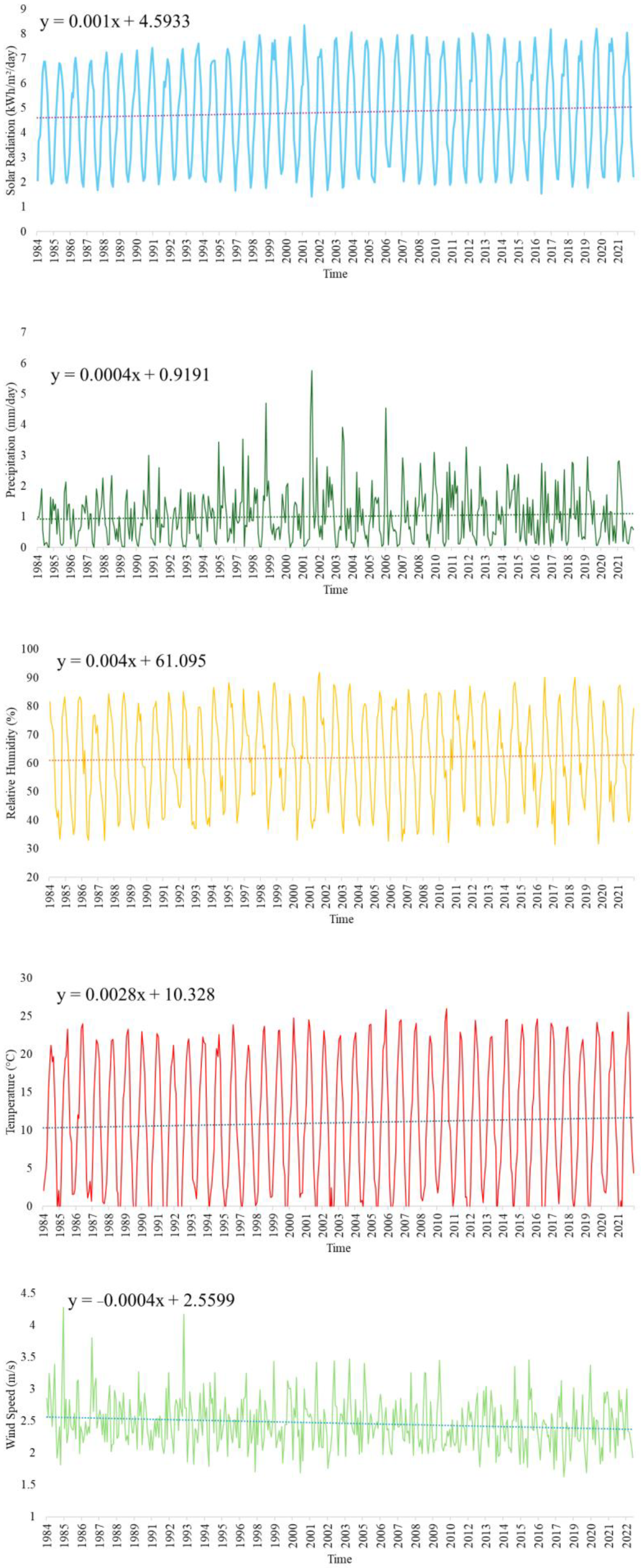
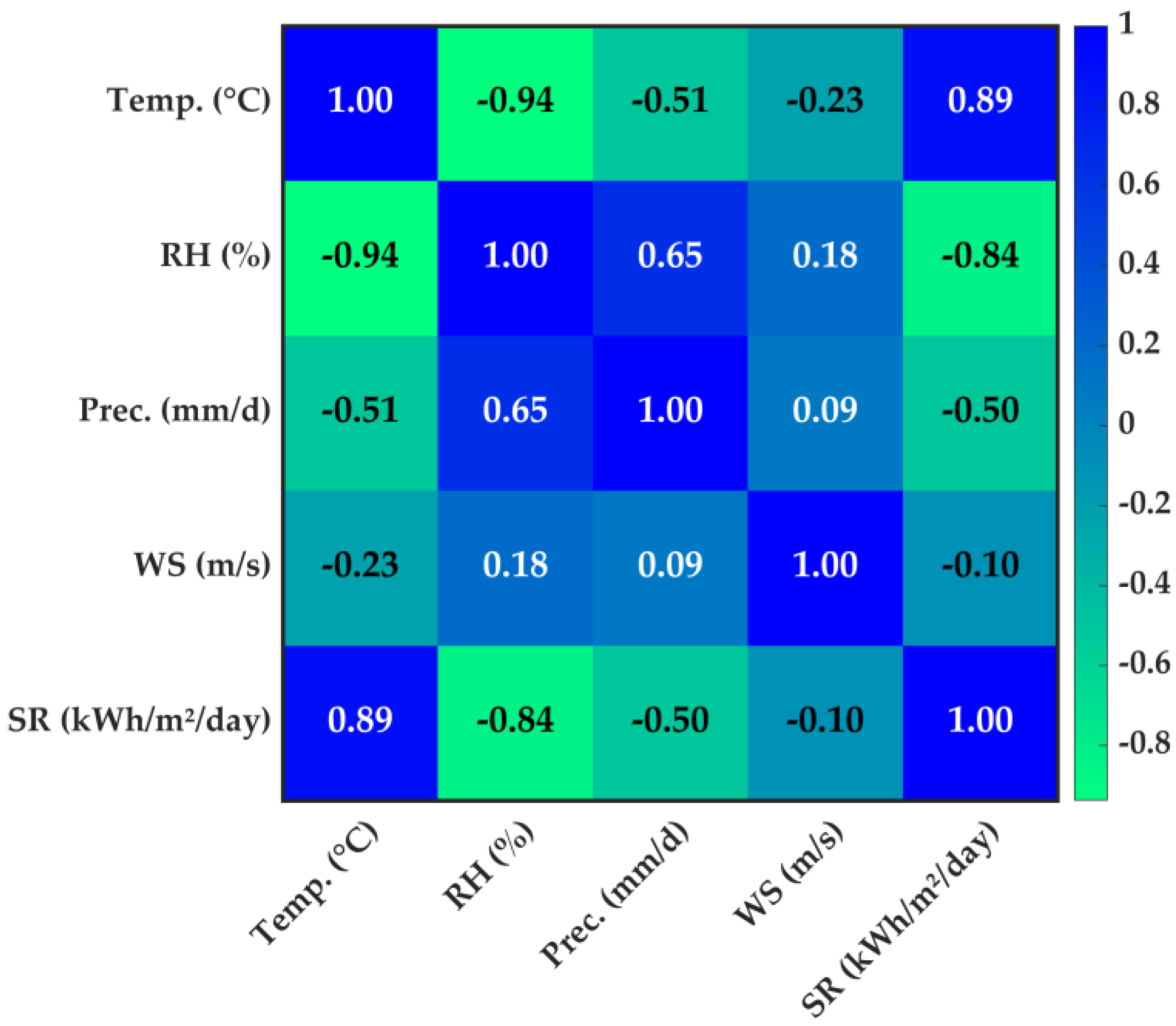
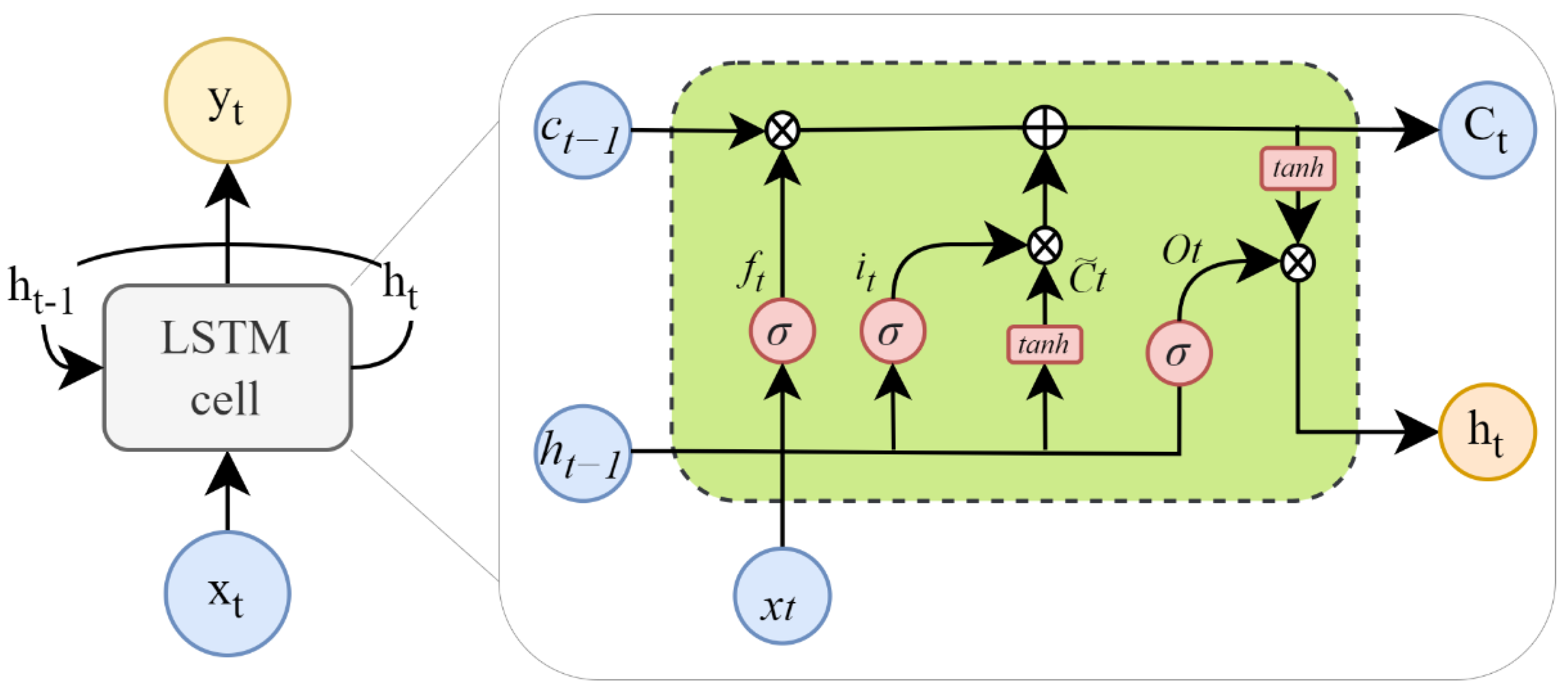

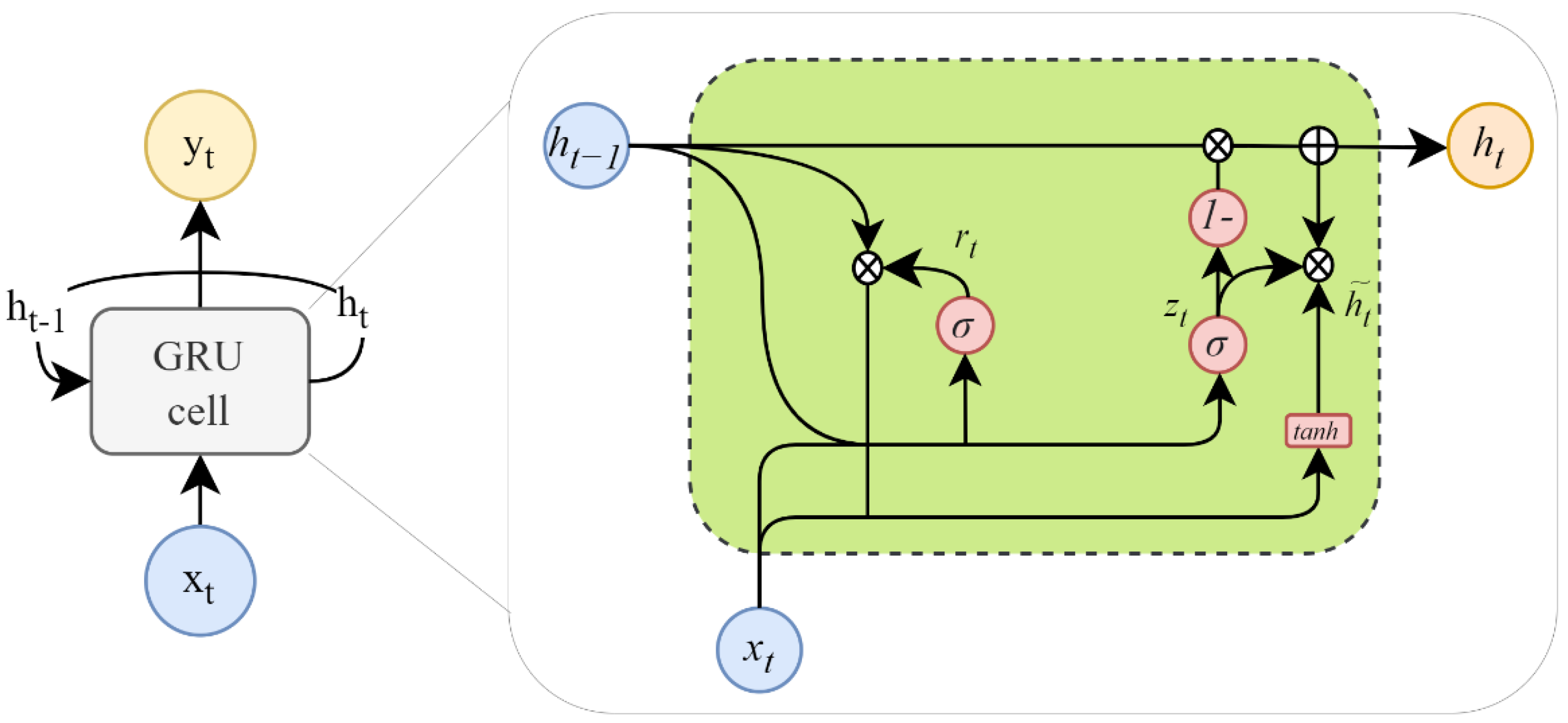


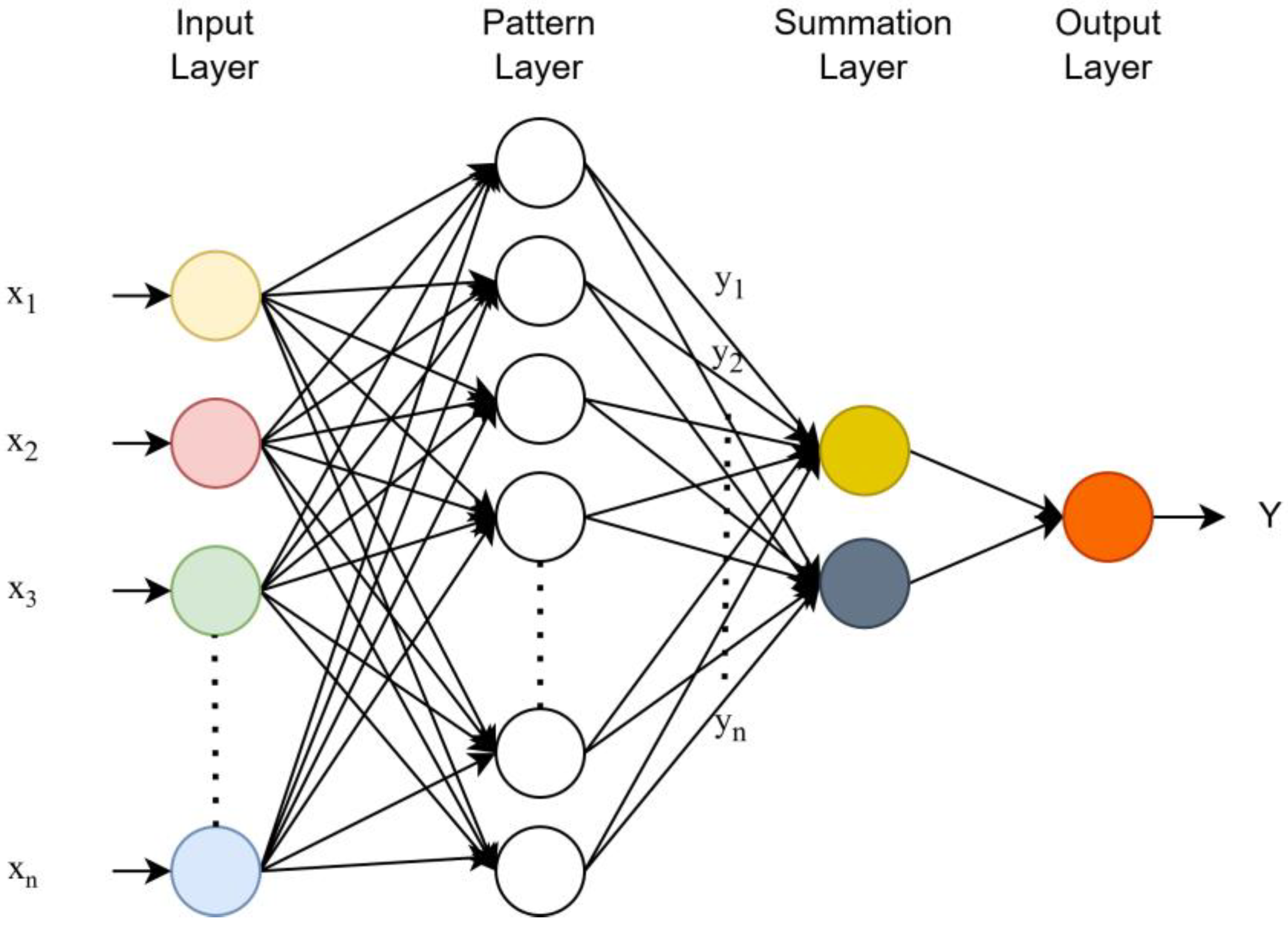


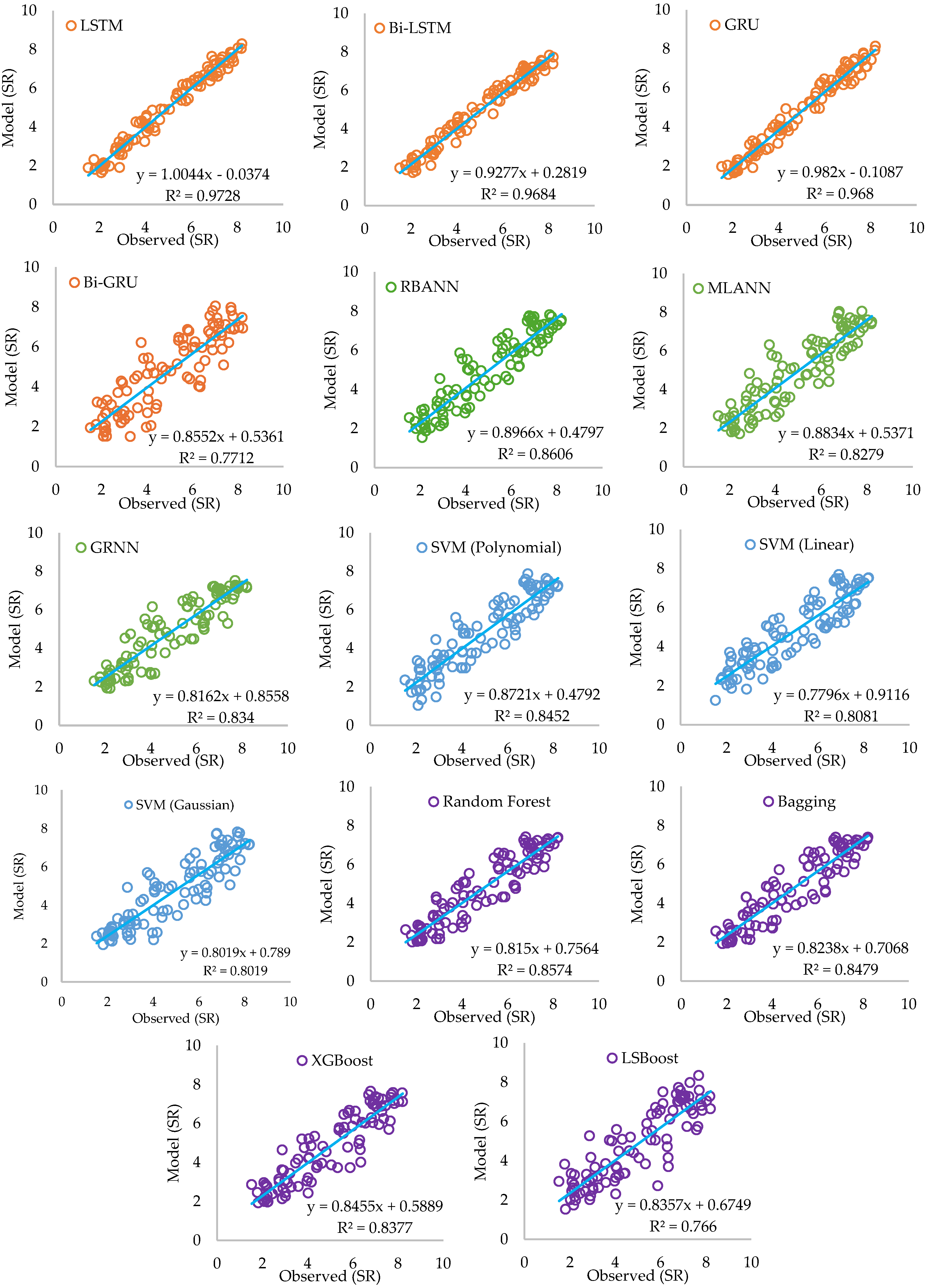
| Parameter | Temp. (°C) | RH (%) | Prec. (mm/d) | WS (m/s) | SR (kWh/m2/d) |
|---|---|---|---|---|---|
| Mean | 10.99 | 62.04 | 1.01 | 2.46 | 4.81 |
| Median | 11.02 | 62.9 | 0.805 | 2.42 | 4.81 |
| Standard Deviation | 8.44 | 15.86 | 0.86 | 0.39 | 1.96 |
| Range | 30.16 | 60.41 | 5.76 | 2.65 | 6.92 |
| Max | 26 | 91.96 | 5.76 | 4.28 | 8.34 |
| Min | −4.16 | 31.55 | 0 | 1.63 | 1.42 |
| Metrics | Maximum | Minimum | Equation | |
|---|---|---|---|---|
| ∞ | 0 | (15) | ||
| ∞ | 0 | (16) | ||
| 1 | 0 | (17) |
| Abbreviation | Model Structure | Model Parameters |
|---|---|---|
| ANN | MLANN | net.trainParam.epochs: 100; net.trainParam.goal: 1 × 10−5; Activation Function: Log-Sigmoid Training Algorithm: Levenberg-Marquardt Number of Neuron: 30 |
| RBANN | Spread: 0.01 to 0.3 Number of Neuron:30 | |
| GRNN | Spread: 0.01 to 0.3 | |
| SVM | Linear | Kernel Function: Linear C (Regularization Parameter): auto Standardize: true |
| Gaussian | Kernel Function: Gaussian C (Regularization Parameter): auto Standardize: true | |
| Polynomial | Kernel Function: Polynomial C (Regularization Parameter): auto Standardize: true | |
| Tree | LSBoost | NumLearningCycles: 100 LearnRate: 0.1 Standardize: true |
| Bagging | NumLearningCycles: 100 MinParentSize:10 Loss Function: cumulative | |
| XGBoost | NumLearningCycles: 100 LearnRate: 0.1 Standardize: true | |
| Random Forest | NumTrees: 100 MaxFeatures: Sqrt InBagFraction: 1.0 | |
| Deep-Learning | Bi-LSTM LSTM GRU Bi-GRU | Optimizer: ADAM NumHiddenUnits: 30 InitialLearnRate: 0.05 LearnRateDropFactor: 0.2 MaxEpochs: 100–300 |
| Model | Train | Test | Test Rank | ||||
|---|---|---|---|---|---|---|---|
| RMSE | MAE | R2 | RMSE | MAE | R2 | ||
| LSTM | 0.19 | 0.15 | 1.00 | 0.34 | 0.27 | 0.97 | 1 |
| Bi-LSTM | 0.15 | 0.12 | 1.00 | 0.37 | 0.31 | 0.97 | 2 |
| GRU | 0.17 | 0.13 | 0.99 | 0.41 | 0.33 | 0.97 | 3 |
| RTYSA | 0.73 | 0.59 | 0.86 | 0.75 | 0.62 | 0.86 | 4 |
| Random Forest | 0.52 | 0.42 | 0.93 | 0.77 | 0.64 | 0.86 | 5 |
| Bagging | 0.51 | 0.41 | 0.93 | 0.80 | 0.66 | 0.85 | 6 |
| SVM (Poly.) | 0.73 | 0.59 | 0.86 | 0.80 | 0.68 | 0.85 | 7 |
| GRNN | 0.57 | 0.44 | 0.92 | 0.82 | 0.66 | 0.83 | 8 |
| XGBoost | 0.37 | 0.29 | 0.97 | 0.82 | 0.65 | 0.84 | 9 |
| MLANN | 0.66 | 0.52 | 0.89 | 0.84 | 0.68 | 0.83 | 10 |
| SVM (Linear) | 0.88 | 0.74 | 0.80 | 0.89 | 0.76 | 0.81 | 11 |
| SVM (Gaussian) | 0.60 | 0.45 | 0.91 | 0.91 | 0.72 | 0.80 | 12 |
| LSBoost | 0.08 | 0.06 | 1.00 | 0.99 | 0.76 | 0.77 | 13 |
| Bi-GRU | 0.31 | 0.24 | 0.98 | 0.99 | 0.80 | 0.75 | 14 |
| Model | Kruskal–Wallis p-Value | ANOVA p-Value |
|---|---|---|
| LSTM | 0.889 | 0.957 |
| Bi-LSTM | 0.742 | 0.790 |
| GRU | 0.410 | 0.495 |
| RTYSA | 0.914 | 0.914 |
| Random Forest | 0.549 | 0.564 |
| Bagging | 0.521 | 0.552 |
| SVM (Polynomial) | 0.608 | 0.589 |
| GRNN | 0.820 | 0.850 |
| XGBoost | 0.503 | 0.532 |
| MLANN | 0.888 | 0.892 |
| SVM (Linear) | 0.567 | 0.514 |
| SVM (Gaussian) | 0.525 | 0.491 |
| LSBoost | 0.653 | 0.630 |
| Bi-GRU | 0.481 | 0.532 |
Disclaimer/Publisher’s Note: The statements, opinions and data contained in all publications are solely those of the individual author(s) and contributor(s) and not of MDPI and/or the editor(s). MDPI and/or the editor(s) disclaim responsibility for any injury to people or property resulting from any ideas, methods, instructions or products referred to in the content. |
© 2025 by the author. Licensee MDPI, Basel, Switzerland. This article is an open access article distributed under the terms and conditions of the Creative Commons Attribution (CC BY) license (https://creativecommons.org/licenses/by/4.0/).
Share and Cite
Demir, V. Evaluation of Solar Radiation Prediction Models Using AI: A Performance Comparison in the High-Potential Region of Konya, Türkiye. Atmosphere 2025, 16, 398. https://doi.org/10.3390/atmos16040398
Demir V. Evaluation of Solar Radiation Prediction Models Using AI: A Performance Comparison in the High-Potential Region of Konya, Türkiye. Atmosphere. 2025; 16(4):398. https://doi.org/10.3390/atmos16040398
Chicago/Turabian StyleDemir, Vahdettin. 2025. "Evaluation of Solar Radiation Prediction Models Using AI: A Performance Comparison in the High-Potential Region of Konya, Türkiye" Atmosphere 16, no. 4: 398. https://doi.org/10.3390/atmos16040398
APA StyleDemir, V. (2025). Evaluation of Solar Radiation Prediction Models Using AI: A Performance Comparison in the High-Potential Region of Konya, Türkiye. Atmosphere, 16(4), 398. https://doi.org/10.3390/atmos16040398






